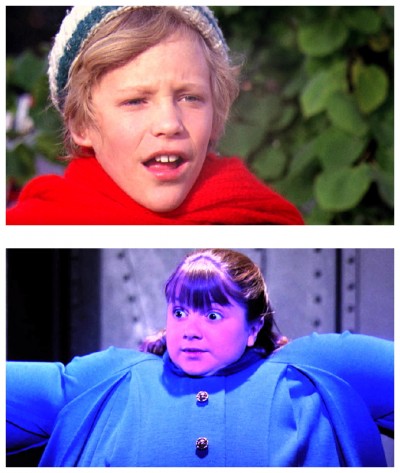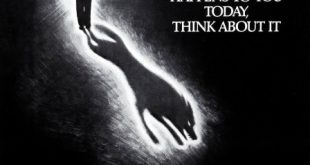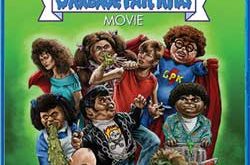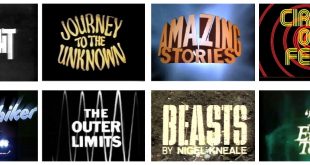 SYNOPSIS::
SYNOPSIS::
“The world is astounded when Willy Wonka, for years a recluse in his factory, announces that five lucky people will be given a tour of the factory, shown all the secrets of his amazing candy, and one will win a lifetime supply of Wonka chocolate. Nobody wants the prize more than young Charlie, but as his family is so poor that buying even one bar of chocolate is a treat, buying enough bars to find one of the five golden tickets is unlikely in the extreme. But in movieland, magic can happen. Charlie, along with four somewhat odious other children, get the chance of a lifetime and a tour of the factory. Along the way, mild disasters befall each of the odious children, but can Charlie beat the odds and grab the brass ring?” (courtesy IMDB)
REVIEW:
Some adult fantasy films, like A Midsummer Night’s Sex Comedy (1982), are more authentically child-like than the slightly mechanical fantasies that are especially designed for children. Consider Doctor Dolittle (1967), Chitty Chitty Bang Bang (1968) and, of course, most of the Disney films. Two of the more notable Disney efforts were The Love Bug (1968) and Bedknobs And Broomsticks (1971). Unfortunately, the most memorable children’s fantasy of the era was such a big box-office flop, that the financing company Quaker Oats never made another film. Nowadays, however, it’s considered by many to be a small-scale cult classic. This was Willy Wonka And The Chocolate Factory (1971) starring Gene Wilder as the eponymous Wonka.
 Actually, Joel Grey was the first choice for the role of Willy Wonka but was dismissed as unimposing, then the role was offered to Ron Moody who declined. Roald Dahl‘s original choice to play Willy Wonka was Spike Milligan, and Jon Pertwee had to turn down the role because he was in the tight schedule of Doctor Who at the time. All six members of Monty Python’s Flying Circus – Graham Chapman, John Cleese, Eric Idle, Terry Gilliam, Terry Jones and Michael Palin – had all expressed great interest in playing the role, but they were deemed not big enough names for an international audience. Cleese, Idle and Palin were seriously considered for the same role in Tim Burton’s remake.
Actually, Joel Grey was the first choice for the role of Willy Wonka but was dismissed as unimposing, then the role was offered to Ron Moody who declined. Roald Dahl‘s original choice to play Willy Wonka was Spike Milligan, and Jon Pertwee had to turn down the role because he was in the tight schedule of Doctor Who at the time. All six members of Monty Python’s Flying Circus – Graham Chapman, John Cleese, Eric Idle, Terry Gilliam, Terry Jones and Michael Palin – had all expressed great interest in playing the role, but they were deemed not big enough names for an international audience. Cleese, Idle and Palin were seriously considered for the same role in Tim Burton’s remake.
 When Gene Wilder walked in to audition, director Mel Stuart knew before he’d even uttered a single word that he had found his Willy Wonka. The audition convinced him even further, so when Wilder finished and left the room, Stuart chased him down the hallway, cut him off at the elevator, grabbed his arm and said, “You’re doing this picture, no two ways about it! You are Willy Wonka!” After reading the script, Wilder agreed to make the film under one condition: that he would be allowed to somersault in the scene when he first meets the children. When asked why, Wilder replied that having Willy Wonka start out limping and end up somersaulting would set the tone for that character. He wanted to portray him as someone whose actions were completely unpredictable. His request to somersault was granted.
When Gene Wilder walked in to audition, director Mel Stuart knew before he’d even uttered a single word that he had found his Willy Wonka. The audition convinced him even further, so when Wilder finished and left the room, Stuart chased him down the hallway, cut him off at the elevator, grabbed his arm and said, “You’re doing this picture, no two ways about it! You are Willy Wonka!” After reading the script, Wilder agreed to make the film under one condition: that he would be allowed to somersault in the scene when he first meets the children. When asked why, Wilder replied that having Willy Wonka start out limping and end up somersaulting would set the tone for that character. He wanted to portray him as someone whose actions were completely unpredictable. His request to somersault was granted.
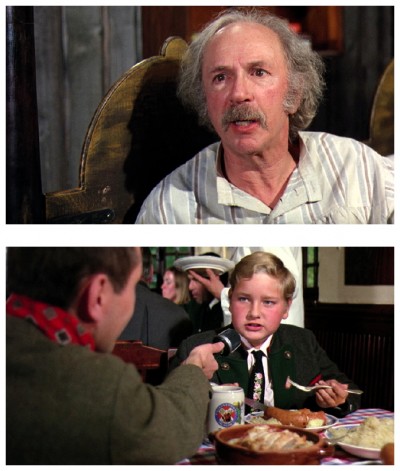 The story involves enough candy for a lifetime to be won by the children who find the five golden tickets, including Charlie Bucket (Peter Ostrum), a nice ordinary boy who lives with his impoverished mother and four grandparents. Charlie decides to take along Grandpa Joe (Jack Albertson), as the prize involves a trip around the factory, which proves to be a sinister fantasyland where literally sticky ends are a constant risk. Wonka is aggressive, mysterious and unpredictable – it is really quite a menacing performance, not at all what we expect in a children’s film. The four nasty children receive bizarre and violent punishments for being greedy and spoiled.
The story involves enough candy for a lifetime to be won by the children who find the five golden tickets, including Charlie Bucket (Peter Ostrum), a nice ordinary boy who lives with his impoverished mother and four grandparents. Charlie decides to take along Grandpa Joe (Jack Albertson), as the prize involves a trip around the factory, which proves to be a sinister fantasyland where literally sticky ends are a constant risk. Wonka is aggressive, mysterious and unpredictable – it is really quite a menacing performance, not at all what we expect in a children’s film. The four nasty children receive bizarre and violent punishments for being greedy and spoiled.
 The chocolate factory is a place of surreal threat with, for example, images of a beheaded chicken and a centipede crawling on a man’s face cast on the walls of the tunnel traversed by the S.S. Wonkatania. By the way, the face in the psychedelic tunnel is that of Walon Green, friend of director Stuart and screenwriter of The Wild Bunch (1969), the only person who would agree to let a centipede crawl on his face for the sake of a children’s film. Fortunately, Charlie does not have to go through with his plan to steal an Everlasting Gobstopper and give it to Wonka’s competitors. When he returns the candy, Wonka instantly becomes benign, indeed, becoming the father figure Charlie never had. Charlie, when the time comes, will become the new king of the chocolate factory.
The chocolate factory is a place of surreal threat with, for example, images of a beheaded chicken and a centipede crawling on a man’s face cast on the walls of the tunnel traversed by the S.S. Wonkatania. By the way, the face in the psychedelic tunnel is that of Walon Green, friend of director Stuart and screenwriter of The Wild Bunch (1969), the only person who would agree to let a centipede crawl on his face for the sake of a children’s film. Fortunately, Charlie does not have to go through with his plan to steal an Everlasting Gobstopper and give it to Wonka’s competitors. When he returns the candy, Wonka instantly becomes benign, indeed, becoming the father figure Charlie never had. Charlie, when the time comes, will become the new king of the chocolate factory.
 Author Roald Dahl adapted his own novel Charlie And The Chocolate Factory and the result is one of the most bizarre children’s films ever made. Dahl was so angry with the treatment of his book (mainly stemming from the massive rewrite by David Seltzer) that he refused permission for the book’s sequel, Charlie And The Great Glass Elevator, to be filmed. Dahl was so unhappy that he refused to ever watch the completed film in its entirety. Once, while staying in a hotel, he accidentally tuned into a television airing of the movie, but changed the channel immediately when he realised what he was watching. However, photographic evidence contradicts this – behind-the-scenes footage shows him looking quite happy while visiting the set, and he even attended the premiere. Director Stuart and producer David L. Wolper brought in writer Seltzer because Dahl’s screenplay was missing many story elements they felt were needed, such as a villain.
Author Roald Dahl adapted his own novel Charlie And The Chocolate Factory and the result is one of the most bizarre children’s films ever made. Dahl was so angry with the treatment of his book (mainly stemming from the massive rewrite by David Seltzer) that he refused permission for the book’s sequel, Charlie And The Great Glass Elevator, to be filmed. Dahl was so unhappy that he refused to ever watch the completed film in its entirety. Once, while staying in a hotel, he accidentally tuned into a television airing of the movie, but changed the channel immediately when he realised what he was watching. However, photographic evidence contradicts this – behind-the-scenes footage shows him looking quite happy while visiting the set, and he even attended the premiere. Director Stuart and producer David L. Wolper brought in writer Seltzer because Dahl’s screenplay was missing many story elements they felt were needed, such as a villain.
 As critic Henry Blinder astutely points out, the film version actually improves on the novel because it has to do with more than just a boy proving himself to be honest. It is also about a man searching for an heir to whom he can leave his business and a boy looking for a surrogate father. Significantly, in the book (and the Tim Burton remake) Charlie has a father. First-time viewers, especially children, have much difficulty warming to this film: The tone is dreary, Wonka is scary, the Oompa-Loompas are dreadful concoctions, the kids are shown to be bratty and are treated viciously, and the Leslie Bricusse/Anthony Newley songs – as in the case of Doctor Doolittle the year before – are utterly forgettable, but the lurid dangers of the factory make the film well worth watching, and improves with subsequent viewings: The kids, their parents and the unpredictable Wonka suddenly seem cleverly conceived. No patronising of children here by giving them only the sunny side of life.
As critic Henry Blinder astutely points out, the film version actually improves on the novel because it has to do with more than just a boy proving himself to be honest. It is also about a man searching for an heir to whom he can leave his business and a boy looking for a surrogate father. Significantly, in the book (and the Tim Burton remake) Charlie has a father. First-time viewers, especially children, have much difficulty warming to this film: The tone is dreary, Wonka is scary, the Oompa-Loompas are dreadful concoctions, the kids are shown to be bratty and are treated viciously, and the Leslie Bricusse/Anthony Newley songs – as in the case of Doctor Doolittle the year before – are utterly forgettable, but the lurid dangers of the factory make the film well worth watching, and improves with subsequent viewings: The kids, their parents and the unpredictable Wonka suddenly seem cleverly conceived. No patronising of children here by giving them only the sunny side of life.
 Although the opening credits sequence was filmed at the Toblerone chocolate factory in Switzerland, the expansive Chocolate Room is the real set-piece of the film. The reactions of the actors in some scenes are quite spontaneous. For example, when the children first enter the Chocolate Room and see the candy gardens, their reactions are real, it was really their first view of that particular set. A number of the objects and plants in the Chocolate Room really were edible, including the giant lollipops, in fact about a third of the props in the Chocolate Room was edible. The chocolate river was made of real chocolate, water and cream, but it spoiled very quickly under the hot lights and left a terribly foul smell. It’s on this fragrant note I’ll quickly wrap up this article and politely request your company next week when I have the opportunity to tickle your fear-fancier again with another feather plucked from that cinematic ugly duckling known as…Horror News! Toodles!
Although the opening credits sequence was filmed at the Toblerone chocolate factory in Switzerland, the expansive Chocolate Room is the real set-piece of the film. The reactions of the actors in some scenes are quite spontaneous. For example, when the children first enter the Chocolate Room and see the candy gardens, their reactions are real, it was really their first view of that particular set. A number of the objects and plants in the Chocolate Room really were edible, including the giant lollipops, in fact about a third of the props in the Chocolate Room was edible. The chocolate river was made of real chocolate, water and cream, but it spoiled very quickly under the hot lights and left a terribly foul smell. It’s on this fragrant note I’ll quickly wrap up this article and politely request your company next week when I have the opportunity to tickle your fear-fancier again with another feather plucked from that cinematic ugly duckling known as…Horror News! Toodles!
 Horror News | HNN Official Site | Horror Movies,Trailers, Reviews
Horror News | HNN Official Site | Horror Movies,Trailers, Reviews
